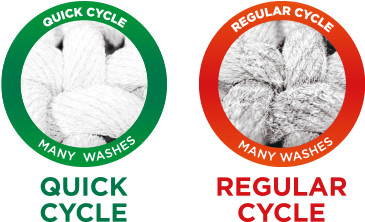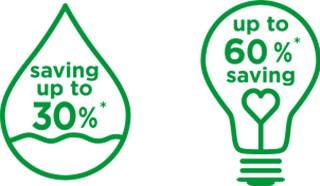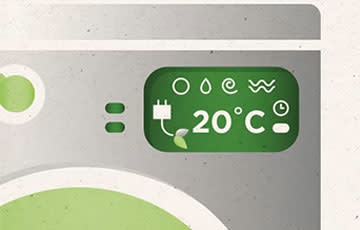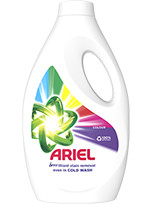Sometimes you need clean clothes in a hurry. Sometimes you don’t have close to a full wash worth of dirty garments. Sometimes you just can’t wait for the normal cycle to finish. Luckily there is another option on most modern washing machines: the quick wash. Let’s see the laundry guide to basics!
A quick wash does pretty much exactly what it describes: it washes your clothes quicker than your normal cycle, usually taking 15 minutes to an hour. While that sounds great, it also means it doesn’t pack the same punch as the regular wash, especially if you want to wash your clothes on a cold wash cycle to protect those bright colours from fading. So why and when would you use the quick wash and cold wash, and what is it, exactly?

Clean in double quick time
There are plenty of reasons why you might want to use quick wash, such as when you:
Have a laundry emergency and need clean clothes in a hurry.
Want to refresh clothes.
Wash everyday clothes with little soiling.
Quick wash only takes up to an hour to do the laundry, which means it has a shorter spin cycle and won’t always reach the same temperature as you would in a regular wash. To get the best results from quick wash:
Only fill your machine up to 40% full.
Only wash clothes with a low level of soiling. The short wash time won’t be enough to clean heavily soiled fabrics like underwear, bedding, and towels.
Increase the dose of your detergent to quick wash for garments with tougher stains.
It’s also perfect for those clothes you need in double quick time. If you have a laundry emergency, like when you’ve got an important meeting on the next day and your favourite shirt needs a wash, then chuck it into a quick wash with a few other whites and in no time at all, your garments will be refreshed and ready for your big meeting.
The quick wash isn’t just quicker than the regular wash, though. You can quickly wash a few clothes without using a lot of energy, in fact, a quick wash can save up to 60% of energy* compared to a regular cotton cycle, and that’s not all. However, if your laundry contains garments made from heavy fabrics, they may come out soaking wet on a quick cycle, as the spin time is much shorter. Should this happen, simply put the garment back in and use the spin option on your machine to remove the excess water.
Quick, hot, or cold wash?
Picking the right water temperature can make a big difference to your laundry results, so you may be asking yourself if you want to use hot or cold water when you wash.
If you’re looking for a deep clean, a quick wash cycle won’t give you the temperature or the duration you need. However if your clothes are only slightly dirty, and you want to protect your colours, then using your machine on cold wash will give you the results you want. Choosing the right temperature setting is as unique as the fabric you’re washing, that’s why we’ve summarised the answers to any questions you may have on washing machine temperature settings, like what temperature is a cold wash, does cold water shrink clothes, or when you should use a hot wash, in the table below.
| Wash Cycle | Temperature | Fabrics | Purpose |
|---|---|---|---|
| Cold wash | 20-30˚C | • Bright colours • Dark colours • Delicate fabrics* Lightly soiled fabrics, items that may be at risk from shrinking.*on delicate cycle option | Using cold wash saves energy while washing, but it also protects colours from running or from dye transfer. Gentle on delicate fabrics. |
| Warm wash | 30-40˚C | • Synthetic fabric and blends Everyday washing, heavy soiling | Provides good cleaning power while still preserving colours in most garments. Good for washing everyday clothes that require effective stain removal. |
| Hot wash | 40-60˚C (or more) | • Cotton fabrics • Bed sheets • Towels • Cotton underwear • Baby clothes Garments that require a deep clean | Removes tough stains, kills bacteria, removes mould and gives garments a deep clean. |
When it comes to picking the right wash cycle, it’s important to understand that different settings may come at different washing temperatures. While quick wash usually comes on a warm or cold wash setting, washing on another setting, like cotton, will wash your clothes at hot temperatures. You can see more about picking the right cycle for you in our article on washing cycles. To make sure that your clothes can be washed on a particular setting, always check the wash label.
There’s another factor you should consider when choosing a program and washing temperature: 60% of laundry’s carbon footprint comes from heating water*, so if everyone in the UK decided to turn down their washing temperature, we could save an amount of CO2 that’s equal to half a million cars off the road**. You’ll be able to get a brilliant clean while saving a lot of energy and reducing the environmental impact.
* Simplified LCA break-down
** illustration of turning down the washing temperature from 40°C to 20°C, expressed in total UK CO2 savings in car emissions per year.
Use quick wash to care for your washing machine and clothes
Quick washes are better for your washing machine, reducing their running time and helping to care for them for longer.
Quick washes are also better for your clothes. By causing less damage to the clothing fibres, they allow your clothes to last longer, saving you again.
Check the laundry symbols on the fabric care labels on your garment to find the best temperature to wash your clothes and which wash cycle you should use.
1
Help to keep clothes looking newer for longer.

2
Care for your machine for longer.

3
Help protect the environment with energy and water savings.

As always, check your washing machine’s instruction booklet. Sometimes the quick wash can be even more efficient than the eco cycle, giving you yet another reason to use it. Just make sure to separate out those very dirty garments that need a full length wash.
Related articles

How to save energy and help protect our planet
When doing your laundry, you may not be thinking about protecting the planet – but we are.
How to remove hair dye stains
You want to colour your hair, not dye your clothes, but accidents happen. Since hair dye stains are still a dye after all, they’re designed to leave stains.
How to remove cough syrup stains
You’re reaching for the medicine to calm that cough, and you accidentally spill it down your shirt instead.







